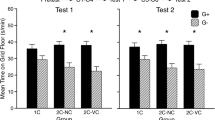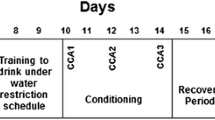Abstract
Mice selectively bred for sensitivity (COLD) or insensitivity (HOT) to the hypothermic effect of ethanol were tested in three tasks purported to assess ethanol's hedonic properties: place conditioning, taste conditioning, and ethanol drinking. In the place conditioning task, distinctive tactile (floor) stimuli were differentially paired with injection of ethanol (2.25 g/kg) or saline, and preference for the tactile stimuli was assessed during a choice test without ethanol. In the taste conditioning task, fluid-deprived mice were given repeated access to saccharin followed by injection of ethanol (2.25 g/kg). In the drinking task, mice were given access on alternate days to a single drinking tube containing water or ethanol in a concentration that gradually increased from 1 to 12% (v/v) over days. HOT mice showed greater conditioned preference for ethanol-paired tactile cues, greater aversion for ethanol-paired flavor cues, and drank less ethanol at concentrations above 5% than COLD mice. HOT mice also showed higher levels of ethanol-stimulated activity than COLD mice. Control experiments indicated that the lines did not differ in initial preference for the tactile and flavor stimuli used in the conditioning tasks. Because the same line differences were seen in mice selected from two genetically independent populations, these studies offer strong evidence of genetic correlations between ethanol's thermal effect and its effect on activity, place conditioning and taste conditioning. Evidence of a genetic correlation between ethanol's thermal effect and ethanol drinking, however, is weaker since it is based on a line difference observed in only one of the genetic replicates. In general, these findings suggest commonality in the biological mechanisms underlying ethanol's thermal effect and its effect in each behavioral task. This overall pattern of genetic correlations might indicate that these tasks measure the same motivational effect of ethanol.
Similar content being viewed by others
References
Baker TB, Cannon DS (1982) Alcohol and taste-mediated learning. Addict Behav 7:221–230
Belknap JK, Belknap ND, Berg JH, Coleman R (1977) Preabsorptive vs. postabsorptive control of ethanol intake in C57BL/6J and DBA/2J mice. Behav Genet 7:413–425
Bozarth, MA (ed) (1987) Methods for assessing the reinforcing properties of abused drugs. Springer, Berlin Heidelberg New York
Bozarth MA (1990) Evidence for the rewarding effects of ethanol using the conditioned place preference method. Pharmacol Biochem Behav 35:485–487
Carr GD, Fibiger HC, Phillips AG (1989) Conditioned place preference as a measure of drug reward. In: Liebman JM, Cooper SJ (eds) Neuropharmacological basis of reward. Oxford, New York, pp 264–319
Crabbe JC (1983) Sensitivity to ethanol in inbred mice: genotypic correlations among several behavioral responses. Behav Neurosci 97:280–289
Crabbe JC (1989) Genetic animal models in the study of alcoholism. Alcohol Clin Exp Res 13:120–127
Crabbe JC, Kosobud A, Young ER, Janowsky JS (1983) Polygenic and single-gene determination of responses to ethanol in BXD/Ty recombinant inbred mouse strains. Neurobehav Toxicol Teratol 5:181–187
Crabbe JC, Kosobud A, Tam BR, Young ER, Deutsch CM (1987) Genetic selection of mouse lines sensitive (COLD) and resistant (HOT) to acute ethanol hypothermia. Alcohol Drug Res 7:163–174
Crabbe JC, Feller DJ, Dorow JS (1989) Sensitivity and tolerance to ethanol-induced hypothermia in genetically selected mice. J Pharmacol Exp Ther 249:456–461
Crabbe JC, Phillips TJ, Kosobud A, Belknap JK (1990) Estimation of genetic correlation: interpretation of experiments using selectively bred and inbred animals. Alcohol Clin Exp Res 14:141–151
Cunningham CL (1979) Flavor and location aversions produced by ethanol. Behav Neural Biol 27:362–367
Cunningham CL (1981) Spatial aversion conditioning with ethanol. Pharmacol Biochem Behav 14:263–264
Cunningham CL, Niehus DR (1989) Effect of ingestion-contingent hypothermia on ethanol self-administration. Alcohol 6:377–380
Cunningham CL, Prather LK (1990) Ethanol-induced conditioned place preference in mice: role of conditioning trial duration. Soc Neurosci Abstr 16:755
Cunningham CL, Hawks DM, Niehus DR (1988) Role of hypothermia in ethanol-induced conditioned taste aversion. Psychopharmacology 95:318–322
Cunningham CL, Hunter JS, Bachtold JF (1990a) Conditioned taste aversion and ethanol-induced hypothermia. Alcohol Clin Exp Res 14:280
Cunningham CL, Mallot DH, Prather LK (1990b) Genetic differences in ethanol-induced place preference conditioning. Alcohol Clin Exp Res 14:280
Eriksson K, Rusi M (1981) Finnish selection studies on alcohol-related behaviors: general outline. In: McClearn GE, Deitrich RA, Erwin VG (eds) Development of animal models as pharmacogenetic tools, NIAAA Research Monograph No 6, Rockville, pp 87–117
Froehlich JC, Harts J, Lumeng L, Li T-K (1988) Differences in response to the aversive properties of ethanol in rats selectively bred for oral ethanol preference. Pharmacol Biochem Behav 31:215–222
Goodwin DW (1979) Alcoholism and heredity: a review and hypothesis. Arch Gen Psychiatry 36:57–61
Horowitz GP, Whitney G (1975) Alcohol-induced conditioned aversion: Genotypic specificity in mice(Mus musculus). J Comp Physiol Psychol 89:340–346
Hunt T, Amit Z (1987) Conditioned taste aversion induced by self-administered drugs: paradox revisited. Neurosci Biobehav Rev 11:107–130
Li T-K, Lumeng L, McBride WJ, Waller MB (1981) Indiana selection studies on alcohol-related behaviors. In: McClearn GE, Deitrich RA, Erwin VG (eds) Development of animal models as pharmacogenetic tools. NIAAA Research Monograph No 6, Rockville, pp 171–191
Liebman JM, Cooper SJ (eds) (1989) Neuropharmacological basis of reward. Oxford, New York
Lubow RE (1973) Latent inhibition. Psychol Bull 79:398–407
MacPhail RC, Elsmore TF (1980) Ethanol-induced flavor aversions in mice: a behavior-genetic analysis. Neurotoxicology 1:625–634
McClearn, GE (1983) Genetic factors in alcohol abuse: animal models. In: Kissin B, Begleiter H (eds) The pathogenesis of alcoholism. Plenum Press, New York, pp 1–30
McClearn GE, Rodgers DA (1959) Differences in alcohol preference among inbred strains of mice. Q J Stud Alcohol 20:691–695
McClearn GE, Rodgers DA (1961) Genetic factors in alcohol preference of laboratory mice. J Comp Physiol Psychol 54:116–119
Myers RD, Veale WL (1972) The determinants of alcohol preference in animals. In: Kissin B, Begleiter H (eds) The biology of alcoholism: physiology and behavior. Plenum Press, New York, pp 131–168
Neisewander JL, Pierce RC, Bardo MT (1990) Naloxone enhances the expression of morphine-induced conditioned place preference. Psychopharmacology 100:201–205
Phillips TJ, Feller DJ, Crabbe JC (1989) Selected mouse lines alcohol, and behavior. Experientia 45:805–827
Reicher MA, Holman EW (1977) Location preference and flavor aversion reinforced by amphetamine in rats. Anim Learn Behav 5:343–346
Reid LD, Hunter GA, Beaman CM, Hubbell CL (1985) Toward understanding ethanol's capacity to be reinforcing: a conditioned place preference following injections of ethanol. Pharmacol Biochem Behav 22:483–487
Riley AL, Tuck DL (1985a) Conditioned taste aversions: a behavioral index of toxicity. Ann NY Acad Sci 443:272–292
Riley AL, Tuck DL (1985b) Conditioned food aversions: a bibliography. Ann NY Acad Sci 443:381–436
Risinger FO, Cunningham CL (1991) Ethanol-induced hyperglycemia in genetically selected mice. Alcoholism: Clin Exp Res (in press)
Rodgers DA (1966) Factors underlying differences in alcohol preference among inbred strains of mice. Psychosom Med 28:498–513
Sherman JE, Jorenby DE, Baker TB (1988) Classical conditioning with alcohol: acquired preferences and aversions, tolerance, and urges/craving. In: Chaudron CD, Wilkinson DA (eds) Theories on alcoholism. Addiction Research Foundation, Toronto, pp 173–237
Smith CA, Holman EW (1987) Rewarding and aversive effects of stimulant drugs in infant rats. Pharmacol Biochem Behav 26:211–215
Solomon RL (1977) An opponent-process theory of acquired motivation: the affective dynamics of addiction. In: Maser JD, Seligman MEP (eds) Psychopathology: experimental models. WH Freeman, San Francisco, pp 66–103
Souza MLO, Masur J (1982) Does hypothermia play a role in the glycemic alterations induced by ethanol? Pharmacol Biochem Behav 16:903–908
Stewart RB, Grupp LA (1981) An investigation of the interaction between the reinforcing properties of food and ethanol using the place preference paradigm. Prog Neuropsychopharmacol 5:609–613
Stewart RB, Grupp LA (1985) Some determinants of the motivational properties of ethanol in the rat: Concurrent administration of food or social stimuli. Psychopharmacology 87:43–50
Stewart RB, Grupp LA (1989) Conditioned place aversion mediated by self-administered ethanol in the rat: A consideration of blood ethanol levels. Pharmacol Biochem Behav 32:431–437
Swerdlow NR, Koob GF (1984) Restrained rats learn amphetamine-conditioned locomotion, but not place preference. Psychopharmacology 84:163–166
Swerdlow NR, Gilbert D, Koob GF (1989) Conditioned drug effects on spatial preference: critical evaluation. In: Boulton AA, Baker GB, Greenshaw AJ (eds) Psychopharmacology (Neuromethods Volume 13) Humana, Clifton NJ, pp 399–446
Tabakoff B, Hoffman PL (1988) A neurobiological theory of alcoholism. In: Chaudron CD, Wilkinson DA (eds) Theories on alcoholism. Addiction Research Foundation, Toronto, pp 29–72
Vezina P, Stewart J (1987a) Conditioned locomotion and place preference elicited by tactile cues paired exclusively with morphine in an open field. Psychopharmacology 91:375–380
Vezina P, Stewart J (1987b) Morphine conditioned place preference and locomotion: the effect of confinement during training. Psychopharmacology 93:257–260
Wise RA, Bozarth MA (1987) A psychomotor stimulant theory of addiction. Psychol Rev 94:469–492
Author information
Authors and Affiliations
Rights and permissions
About this article
Cite this article
Cunningham, C.L., Hallett, C.L., Niehus, D.R. et al. Assessment of ethanol's hedonic effects in mice selectively bred for sensitivity to ethanol-induced hypothermia. Psychopharmacology 105, 84–92 (1991). https://doi.org/10.1007/BF02316868
Received:
Revised:
Issue Date:
DOI: https://doi.org/10.1007/BF02316868




